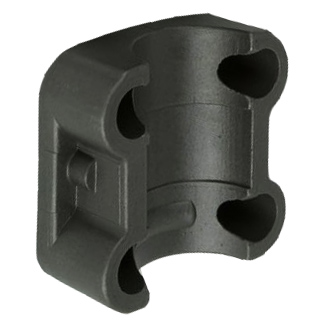
Resin Coated Sand Castings
Material: Ductile Cast Iron Process: Resin Coated Sand Casting Weight: 6.90 kg Application: Freight Rail Cars
OEM Custom resin coated sand mold castings with ductile cast iron, gray cast iron, carbon steel, alloy steel and non-ferrous metal and alloys. We also provide CNC machining services as per your drawings and requirements.
Description
Resin coated sand casting is also called shell mold casting, pre-coated resin sand casting, hot shell molding casting or core casting. The main molding material is the pre-coated phenolic resin sand, which is more expensive than green sand and furan resin sand. Moreover, this sand can not be recycle used. Therefore, the shell molding castings have higher costs than sand casting. However, compared to the green sand casting, the resin coated sand mold castings have many advantages such as higher dimensional tolerance, good surface quality and less casting defects. The shell molding casting process is specially suitable for producing castings of difficult shapes, pressure vessels, weight sensitive and castings requiring superior surface finishes.
What Are The Steps of Resin Coated Sand Casting?
✔ Making Metal Patterns. The pre-coated resin sand needs to be heated in the patterns, so metal patterns are the necessary tooling to make shell molding castings.
✔ Making Pre-coated Sand Mold. After installing the metal patterns on the molding machine, the pre-coated resin sand will be shot into the patterns, and after heating, the resin coating will be molten, then the sand molds become solid sand shell and cores.
✔ Melting the Cast Metal. Using induction furnaces, the materials would be melted into liquid, then the chemical compositions of the liquid iron should be analyzed to match the required numbers and percents.
✔ Pouring Metal. When the melted iron meet the requirements, then they will be poured into the shell molds. Based on different characters of the casting design, the shell molds will be buried into green sand or stacked up by layers.
✔ Shot Blasting, Grinding and Cleaning. After the cooling and solidification of the castings, the risers, gates or additional iron should be cut off and removed. Then the iron castings will be cleaned by sand peening equipment or shot blasting machines. After grinding the gating head and parting lines, the finished casting parts would come, waiting for the further processes if needed.
What Are The Advantages of the Resin Coated Sand Mold Casting?
✔ Shell-mould castings are generally more dimensionally accurate than sand castings.
✔ A smoother surface of the finished castings can be obtained by shell casting.
✔ Lower draft angles than sand castings are required by shell moulds casting.
✔ Permeability of the shell is high and therefore less or no gas inclusions occur.
✔ Shell mold casting process needs very small amount of sand.
✔ Mechanisation is readily possible because of the simple processing involved in shell moulding.
What Are The Steps of Resin Coated Sand Casting?
✔ Making Metal Patterns. The pre-coated resin sand needs to be heated in the patterns, so metal patterns are the necessary tooling to make shell molding castings.
✔ Making Pre-coated Sand Mold. After installing the metal patterns on the molding machine, the pre-coated resin sand will be shot into the patterns, and after heating, the resin coating will be molten, then the sand molds become solid sand shell and cores.
✔ Melting the Cast Metal. Using induction furnaces, the materials would be melted into liquid, then the chemical compositions of the liquid iron should be analyzed to match the required numbers and percents.
✔ Pouring Metal. When the melted iron meet the requirements, then they will be poured into the shell molds. Based on different characters of the casting design, the shell molds will be buried into green sand or stacked up by layers.
✔ Shot Blasting, Grinding and Cleaning. After the cooling and solidification of the castings, the risers, gates or additional iron should be cut off and removed. Then the iron castings will be cleaned by sand peening equipment or shot blasting machines. After grinding the gating head and parting lines, the finished casting parts would come, waiting for the further processes if needed.
What Are The Advantages of the Resin Coated Sand Mold Casting?
✔ Shell-mould castings are generally more dimensionally accurate than sand castings.
✔ A smoother surface of the finished castings can be obtained by shell casting.
✔ Lower draft angles than sand castings are required by shell moulds casting.
✔ Permeability of the shell is high and therefore less or no gas inclusions occur.
✔ Shell mold casting process needs very small amount of sand.
✔ Mechanisation is readily possible because of the simple processing involved in shell moulding.
 русский
русский



